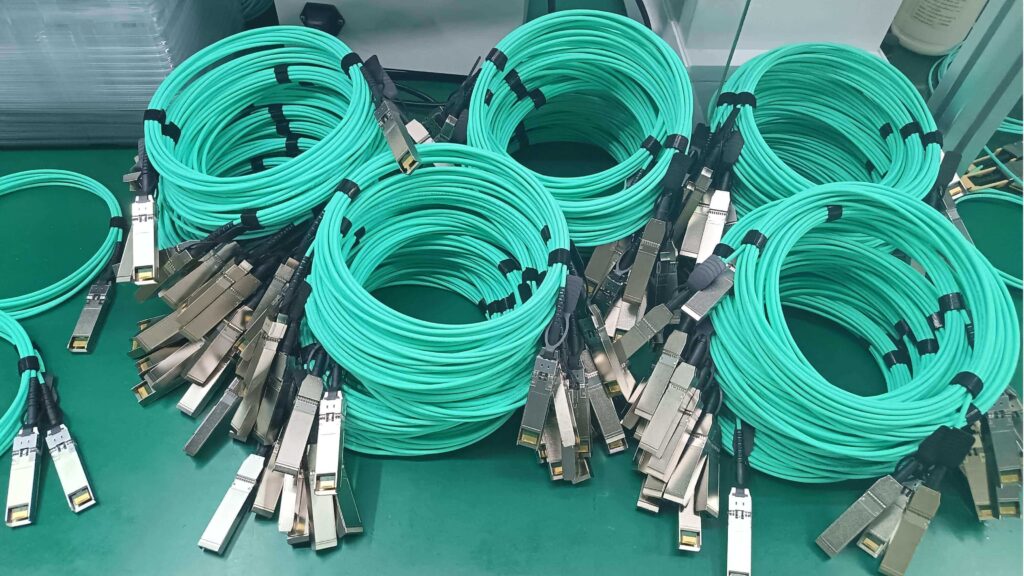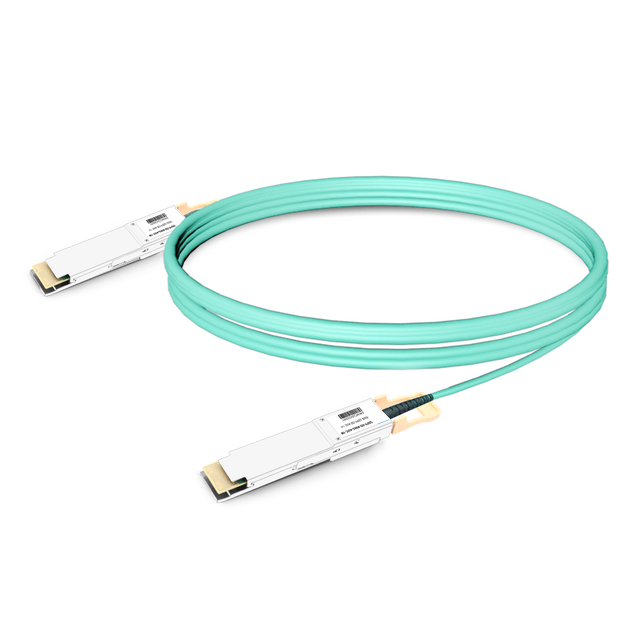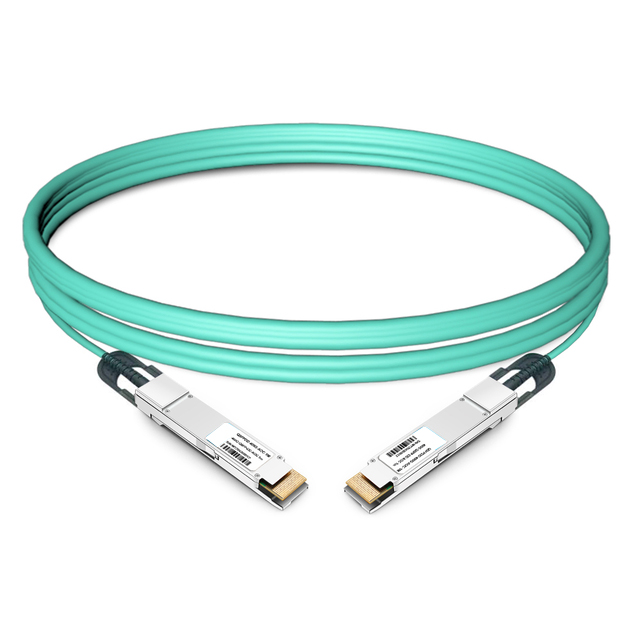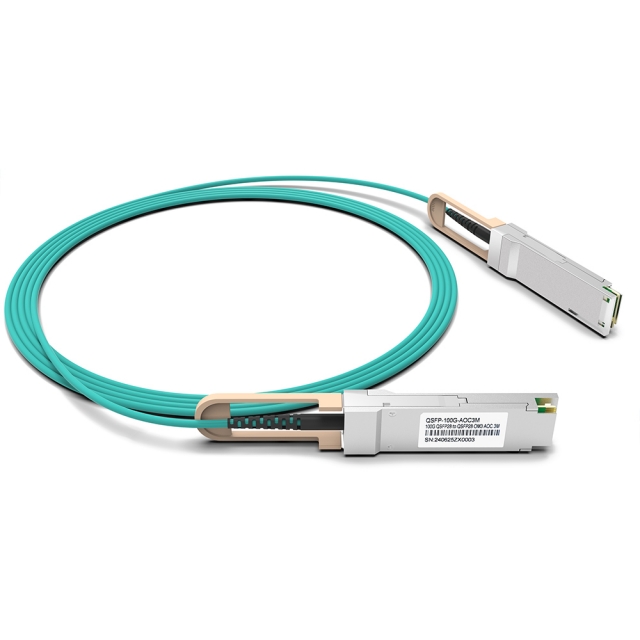Why Use an Active Optical Cable (AOC)?
Modern data centers and AI computing clusters demand ever‑higher throughput and density. Active Optical Cables (AOCs) – fiber-optic cables with built-in transceivers at each end – address these needs by converting electrical signals into light pulses on the fly. Unlike traditional copper Direct Attach Cables, an AOC cable can carry hundreds of gigabits per second over tens of meters with virtually no signal loss. For example, QSFP‑DD AOC cables pack eight 50Gb/s VCSEL lanes into one link, enabling a 400G AOC cable that replaces four 100G copper links.
As one industry analysis notes, “QSFP‑DD 400G AOC cables are ideal for modern data centers, HPC, and cloud computing applications”. In short, AOC cables deliver higher speeds and longer reach than copper, making them critical for AI/HPC workloads and other high‑bandwidth applications.
Advantages of AOC Cables for High‑Bandwidth Networks
Ultra‑high data rates: AOC cables support data rates well beyond 100Gbps. Standard AOC cables today handle up to 400Gb/s per link (and emerging designs support 800Gb/s), matching modern Ethernet and InfiniBand speeds. This makes them ideal for AI training and HPC where servers exchange massive data volumes.
Longer reach: Optical cables carry signals farther than copper. Typical AOC cables span ~100 meters without repeaters (versus only ~5–10 m for passive copper DAC cables). Longer-range AOCs let data centers interconnect distant racks or adjacent buildings while maintaining signal integrity.
EMI immunity: Fiber optics are immune to electromagnetic interference and crosstalk. This yields cleaner, more reliable links in noisy rack environments. For example, Fibrecross highlights that AOC cables “are immune to electromagnetic interference and have higher throughput at longer distances than DAC cables”.
Lightweight and power-efficient: AOC cables are far lighter and thinner than thick copper cables, easing cable management and reducing rack weight. Over long runs, they also use less power: an AOC’s integrated optics consume power efficiently compared to the high driver power copper requires at distance. In practice this means a large fabric of optical links can save significant energy and cooling compared to equivalent copper interconnects.
High port density: Modern AOC form factors (e.g. QSFP‑DD, OSFP) are double‑density, packing more lanes in the same plug. For instance, QSFP‑DD’s compact design allows twice the ports per switch blade compared to QSFP, saving space in dense racks.
These advantages combine to deliver dramatically higher bandwidth over practical data‑center distances. By leveraging high‑speed lasers and parallel optics, AOC cables enable multi‑terabit fabrics with low latency – a must for AI and big‑data workloads.
AOC cables for AI, HPC, and Cloud Environments
AOC cables shine wherever ultra‑fast, low‑latency links are needed. Key use cases include:
GPU/HPC clusters: AI training and scientific supercomputing racks often contain many GPU servers. These nodes must exchange huge datasets at high speed. It’s common to use AOC cable assemblies to connect GPUs and switches in the same rack or row, because AOCs provide the required bandwidth with minimal delay. In fact, “many AI/ML clusters and HPCs use active optical cables to interconnect GPUs and switches,” since a single OSFP 800G AOC cables can deliver 800 Gb/s per link over rack‑scale distances. This flexibility and speed make AOC cables ideal for high-performance GPU fabrics.
Intra‑rack/TOR links: Within each rack or between top-of-rack (TOR) switches and spine switches, 400G (and now 800G) AOC cables replace older copper. A 400G AOC can link a server blade to its TOR switch at 400 Gb/s, far more than any copper DAC. Similarly, double‑density QSFP-DD AOCs enable ultra-fast TOR-to-aggregation links between cabinet rows. For example, a QSFP-DD 400G AOC cables can carry 400 Gb/s between switches in adjacent racks, improving throughput and simplifying wiring.
Cloud datacenter backbones:Hyperscale cloud providers rely on AOC cables to stitch together large fabrics. High-density 400G AOC cables form the backbone between switch clusters or even between data halls. As one analysis notes, 400G AOC cables “can improve internal network performance of cloud computing data centers” and enable “high-speed transmission and sharing of data” between facilities. In essence, every multi-rack, multi-pod AI or cloud service network today either uses or is migrating to AOC cabling to meet its bandwidth demands.
Other high‑speed links: Storage networks (SANs), machine vision systems, and any application with >100Gb/s requirements can leverage AOC cables. The automatic EMI immunity and simplicity of a fixed link (no pluggable transceivers to configure) also make AOC cables attractive for tight, high-throughput environments.
In all these cases, an AOC cable assembly is favored for its combination of bandwidth, distance, and reliability.By contrast, copper would be far more limited in reach or speed. Thus, data‑center architects routinely choose 400G AOC cables today and are beginning to deploy 800G AOC cables for next‑gen fabrics.
High‑Speed 400G AOC Cables
The 400 Gigabit Ethernet era is here, and AOC cables are keeping pace. 400G AOC cables (usually QSFP-DD form factor) integrate 8×50Gb/s laser lanes (PAM4 VCSELs) to realize 400 Gb/s per cable. In practical terms, one QSFP-DD AOC can replace four 100 G links, quadrupling throughput on a single port. These cables also inherit all the general AOC benefits: they are immune to EMI and deliver stable transmission even in electrically noisy racks. Notably, the QSFP-DD interface itself is “double‑density,” so 400G AOC cables allow many more high-speed ports per switch than older form factors.
Examples and applications: Today’s 400G AOC cables are widely used for server-switch links and switch interconnects. They support breakout configurations too – for instance, a 400G QSFP-DD AOC cables can break out into two 200G QSFP56 cables or four 100G QSFP28 connections, offering flexibility between fabric levels.
In cloud and enterprise networks, these 400G AOC cables are deployed in TOR and spine switches, as well as in NIC-to-switch connections for GPU servers. For instance, a double‑density 400G AOC can link two adjacent racks at 400 Gb/s, dramatically improving network throughput. Importantly, 400G AOC cables future‑proof existing 100G and 200G infrastructures. Networks built today with fiber for 400G AOCs will be ready when 800G or higher is needed. Many vendors note that 400G AOCs are ideal for high-density data centers – offering both high bandwidth and support for growth.
Emerging 800G AOC Cable Solutions
Looking ahead, the industry is rolling out 800G Active Optical Cables to keep pace with exploding AI workloads. These are typically OSFP (Octal Small Form-factor Pluggable) cables using 8×100Gb/s lanes.
Such cables maintain the same advantages: they are modular plug-in assemblies (hot-pluggable) but replace copper with optics, so they support tens of meters of reach in a rack. Industry adopters are already shipping 800G AOC cables.
As with 400G, these 800G AOC cables eliminate EMI and can significantly reduce cable bundles compared to multiple lower-speed links. In summary, 800G AOC cable technology is positioned to enable the next wave of data-center bandwidth. By enabling 800 Gb/s lanes per cable, AOC cables ensure that switch fabrics, AI supercomputers, and large-scale distributed systems can scale without being bottlenecked by cabling. Over the next few years, data-center planners will leverage these cables to meet the demands of AI training, 5G infrastructure, and massive cloud services.
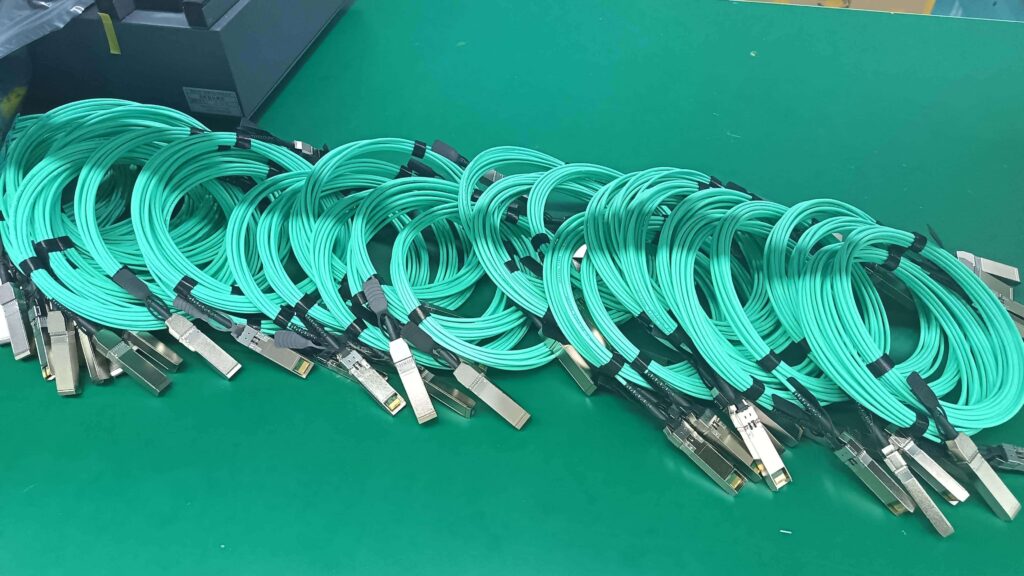
Planning and Deployment Considerations
Cost and compatibility: AOC cables cost more than passive copper DAC cables. (A 400G AOC might cost several times a copper cable). However, cost per bit can be favorable given the performance. Ensure your switches and NICs support the AOC form factor (QSFP‑DD or OSFP). As one vendor cautions, AOC cables may require device support or firmware to be activated.
Installation logistics: Unlike pluggable transceivers, AOC assemblies are fixed cables – you can’t change just the optics. Each AOC must be routed as a single unit, so careful cable management is needed. Installing break-out AOC cables (e.g. 400G-to-4×100G) can be tricky because the connected modules are not removable.
Lifecycle and upgrades: With fixed AOCs, upgrading link speeds typically involves replacing the entire cable assembly. If your infrastructure may jump from 400G to 800G, plan your cabling pathways now. On the other hand, if you use a strategy of pluggable transceivers on fixed fiber (or active electrical cables for shorter reaches), you could reuse fiber spans. In contrast, each failed or obsolete AOC means swapping the full cable+optics. As reported, AOC cables can have a higher failure rate than standalone optics, so a data‑center team should treat each AOC as a critical link element.
- Power and thermal: The embedded lasers and DSPs in AOCs draw power and generate heat. While AOC cables are more energy‑efficient than copper over long distances, their on-board electronics (especially at 800G) consume tens of watts per cable. Ensure your switch and rack environment can handle the power/thermal load of many AOC links.
Physical design: Fortunately, AOC cables are thin and flexible, simplifying cable trays and airflow compared to thick copper bundles. Their immunity to EMI also means cabling can be routed closer to power electronics without issue. Data-center designs should include dedicated fiber trays or vertical management to separate and protect these high-speed links.
By carefully assessing these factors, network architects can smoothly integrate AOC cables into their infrastructure. The result is a future-ready network: AOC-based backbones that support current 400G/800G needs and can be upgraded as bandwidth demands grow.
Conclusion
Active Optical Cables are a cornerstone technology for today’s high-bandwidth networks. By embedding the optics into the cable, AOC assemblies deliver ultra‑fast (400G, 800G+) links with greater reach and lower interference than copper. This makes them ideal for AI clusters, HPC fabrics, cloud backbones, and any scenario where massive data rates are required.
As IT leaders build out next-generation data centers, AOC cables will play a key role – offering unmatched performance in a compact, energy‑efficient form. When weighing cabling options for new or upgraded networks, consider Active Optical Cables as the go-to solution for high-speed, scalable connectivity. With proper planning, AOC cable infrastructure will enable data centers to meet the insatiable demands of AI and cloud computing today and tomorrow.

